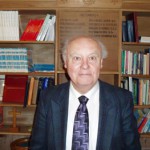 The following is all taken from a booklet published around 2012, written by a member of the congregation, Brian Turner. Photos have been added of many of the items mentioned in the text.
The following is all taken from a booklet published around 2012, written by a member of the congregation, Brian Turner. Photos have been added of many of the items mentioned in the text.
At the start of the booklet the following Acknowledgements were made
-
History of the Church of St James by William Cowling 1962
-
Pennine Village by Roy Mason 1971
-
Past editions of the Parish Magazine
-
The Keighley News
-
The Craven Herald
A History of Silsden Church
1712 - 2012
by Brian Turner
Although 2012 marks the tercentenary of the founding of Silsden Parish church the story really begins in the year 1711, in the reign of Queen Anne. Silsden was then a village of about 600 inhabitants, most of whom were employed in agriculture. The main route through the village followed along Sykes Lane, St John’s St, Kirkgate, Briggate, Bridge St and North St up to Tannery Corner.
Silsden was then part of the Skipton Castle estate, the Earl of Thanet being the Lord of the Manor. It was also in the parish of Kildwick, Kildwick being the only church between Skipton and Keighley. For Silsden people to get to Kildwick was not easy. There were no roads suitable for wheeled horse-drawn traffic, only bridle paths for walkers and those able to go by horseback. Canals and railways were yet to be thought of.
But someone did think that it would be a good idea for Silsden to have its own place of worship. Who it was, we do not know, but we do know that in 1711, four representatives from the village approached the Earl of Thanet to ask for permission to buy land suitable for the building of Silsden’s own church. These four, all described as Yeoman, were Henry Stark and Frances Stark junior of Silsden Moor and Edmund Horsfall and Peter Cowling, of the village of Silsden. It was no light request that these four made, for the providing of a church meant more than just a building, it also meant the furnishings - a communion table, font, pulpit, reading desk, seats, bell, books and other things - an annual stipend and a churchyard.
Light request or not, permission was granted for the building of Silsden’s own church. The land earmarked for the building of this church and for the churchyard, belonged to the Jennings family, a long established Silsden family who had their own coat of arms. They lived at Jennings Hall which stood where the old Vicarage now stands. In March 1711, the land was purchased for 10 shillings. On this land was a barn, similar to that at East Riddlesden Hall, measuring 14 yards 6 inches by 8 yards 18 inches. This barn stood on the site of the present church and it was this barn which was converted to become Silsden’s first place of worship.
A public subscription was set up to raise the money needed for the conversion work which was to cost £66. We do not know for certain what the church looked like on the outside, there being no drawing or painting and certainly no photograph for us to see. But we can assume from written documents that have survived, that the outside of the barn was little altered. It was rectangular in shape with the door in the middle of the South wall, with rectangular windows on each side, with plain glass.
As one entered the door, the three decker pulpit could be seen facing you. The body of the church was filled with box pews which were rented. Other seating was provided by galleries on each side, ie the East and West ends of the building. There was no organ, the music being provided by a few instrumentalists under the West gallery.
Under the East gallery was the altar. Heating was provided by a stove below the pulpit. There was no lighting, so that the one Sunday service was held in the afternoon.
 At the West End of the building was a bell loft (or chamber) in which hung just one bell. This was the bell which can be seen just inside the main door at the West End. On the bell can be seen the inscription “AP 1659”. AP stands for Anne Pembroke known generally as Lady Anne Clifford, who was Countess of Pembroke, as well as Dorset, Montgomery and Westmorland. It originally hung in the Chapel at Skipton Castle, one of Lady Anne's residences. It was given to be used in Silsden’s new church by the Earl of Thanet.
At the West End of the building was a bell loft (or chamber) in which hung just one bell. This was the bell which can be seen just inside the main door at the West End. On the bell can be seen the inscription “AP 1659”. AP stands for Anne Pembroke known generally as Lady Anne Clifford, who was Countess of Pembroke, as well as Dorset, Montgomery and Westmorland. It originally hung in the Chapel at Skipton Castle, one of Lady Anne's residences. It was given to be used in Silsden’s new church by the Earl of Thanet.
Although I have referred, so far, to the building as a church, it was, strictly speaking, a Chapel of Ease, attached to the parish of Kildwick. The vicar of Kildwick was still the vicar of Silsden and the first incumbents at Silsden were known as perpetual curates, the first one being David Clark. He, like his successor Jonathan Jackson, are both recorded as being schoolmasters, a means of supplementing their incomes. Jonathan Jackson, ministering to the people of Silsden from the 1728 to 1766, is our longest serving incumbent. He was followed by George Benson who was here until 1814. Nothing more is known about our first three incumbents.
The church is dedicated to Saint James and the reason for this is that the new Chapel of Ease was consecrated on the feast day of Saint James, July 25th, in 1712. This day was an annual holiday for the people of Silsden, the day on which the Lord of the Manor of Skipton visited the village and matters of dispute, requests, complaints etc were settled. The rest of the day was given over to sports and other means of enjoyment.
In 1712, Kildwick and Silsden were part of the large diocese of York. Thus it was, that the new Chapel of Ease was consecrated by the then Archbishop of York, John Sharp, who had been born and bred in Ivegate in Bradford. The cost of entertaining the archbishop and those who came with him was £12, which was paid by the Earl of Thanet.
The 19th Century
The 19th century began with Silsden Chapel-of-Ease obtaining the licence to register births and deaths. The first entry in the baptism register reads as follows:
1801 Jan 2 John son of Wm Blakey and Ann, his wife, Silsden, Woolcomber
Jan 28 Edmund, son of Wm Barker and his wife, Judith, Silsden, Mason
The same day saw the first entry in the burial register
1801 Jan 28 Isaac Wilson, Gill Grange, Labourer
In 1814, Thomas Fourness Wilson succeeded George Benson as the perpetual curate of Silsden. He brought with him his wife, Eleanor, whom he had married at the beginning of 1813 and his son, John Eden, who had been born in November 1813. The Wilson family lived at Kildwick Hall.
Thomas Wilson was already the incumbent at Whitechapel, Cleckheaton and he continued to hold this office after he was appointed to Silsden, serving the Chapel there by proxy, using curates to do the parish work.
By 1814 the original Chapel was considered too small to accommodate the needs of the 1500 inhabitants, many of whom were unable to attend regularly from want of room. Furthermore, the building, especially the roof, was in a very bad state. As the walls were not considered strong enough to support a new roof, it was thought best to pull down and rebuild the Chapel, enlarging it at the same time. By chance, Napoleon was defeated at Leipzig and sent off to Elba, so that all of England was rejoicing. The Earl of Thanet gave £80 to the people of Silsden to celebrate the long-awaited peace. At a meeting of the local inhabitants, it was agreed that the £80 should be used towards raising the £390 needed to rebuild the Chapel, instead of being used for festivities.
Consequently, with permission from the Archbishop of York, the rebuilding of the Chapel got underway, the work being carried out by two local workmen, Robert Wade and David Tillotson. The new building measured 20 yards by 13 yards and was completed in 1816, as a solitary stone with “1816” cut on it states. This stone is now in the middle of the wall leading up the church hall steps, being placed there after the second building was demolished in 1876 to make way for the present-day building.
Besides being larger, the second building had the distinction of having a tower built at the West End. The cost of the tower was met entirely by Thomas Wilson, who also donated £30 to the rebuilding fund. The new tower contained just one bell, the one that had been given by the Earl of Thanet in 1712. Not only was the original church building no longer large enough, at this time, but the churchyard, then 973 square yards, was too small for the burial of the dead. Consequently, a licence to extend the ground was successfully applied for and a larger burial ground of 2075 square yards was being used by the beginning of 1835.
By this time Thomas Wilson had appointed a curate to look after the parish. This was because he was finding it difficult, for various reasons, to do so himself. He was now a JP for the West Riding and had moved with his wife and six children, from Kildwick Hall to Burley Hall, Burley-in-Wharfedale. This meant a journey of nearly 10 miles each way, on horseback, to officiate at the one service on Sunday afternoon. Not too easy for a man in his 60s.
In fact Thomas Wilson died suddenly on the 17th of October 1837 aged 68.
Silsden’s First Vicar
The curate who Thomas Wilson appointed in 1832 was Richard Heelis, a son of John Heelis, rector of Brougham and Dufton in Westmorland. When Thomas Wilson died, it was Richard Heelis who succeeded him as incumbent. When he arrived in Silsden, he lodged at Highfield, but in 1837, his brother Thomas, an agent to the Earl of Thanet, obtained for him a house and garden adjacent to the church. The house had been a farmhouse attached to Jennings Hall. After a new sitting/dining room was added, Richard Heelis moved in. He became the first Silsden incumbent to live in Silsden. His house soon became known as the Vicarage and he became the first occupant to be called Vicar. In the 1840s, Mr Heelis made two major contributions to the parish of Silsden. Jonathan Mitchell, Silsden's last Parish Clerk, records that “Silsden Chapel had only one service a day on the Sundays ever since it was built, but Mr Richard Heelis, the minister, on the 12th day of November 1843, began with two services a day on the Sundays. And it will remain so”. At this time also, marriages could not be celebrated or solemnised at Silsden. All Silsden couples still had to go to Kildwick. However, Silsden was beginning to develop and become a larger place and Mr Heelis made representations to the Ripon Diocesan authorities, (Silsden now belonged to the new Diocese of Ripon which had been founded in 1836), for a licence to be issued allowing marriages to be solemnised at Silsden. The licence was granted, but Silsden people could still be married at Kildwick if they so wished.
The first marriage in Silsden church was between two Silsden people, a farmer and farmer’s daughter, Stephen Tillotson and Ann Driver, on the 31st July, 1845. During his term of office Mr Heelis celebrated 197 marriages. This included 21 in 1850 and 19 in 1846, the most marriages in any one year during the 19th century. Another Heelis wedding record was to celebrate the most weddings in one day - 4. This happened twice, in 1850 and 1852.
Before all this happened, however, Richard Heelis had himself been married. On the 10th October 1842, he was married to Elizabeth Charnock, the daughter of a corn miller, at Kildwick church. Sadly, their marriage was short lived, for Elizabeth died on the 5th April 1847.
15 years after his wife's death, Richard Heelis’s health deteriorated and he employed a curate to do the parish work. In an attempt to improve his health he went abroad, but sadly he died and was buried at Nice, in France, in March 1865.
Following his death, his four brothers gave the church a silver chalice and paten, in his memory which are still used today.
Later that year, John Marriner became Silsden’s new vicar. During his incumbency church attendance was at its lowest. On 11th May 1873 only four attended the morning service, and 14 came in the afternoon. In September John Marriner was found in a state of intoxication and immediately resigned the living.
The Restoration of 1877
John Marriner was succeeded by Jesse Gleaves at the beginning of 1874. Within weeks of arriving he was confronted with the problem of the education of Silsden’s children. At that time there was a church school situated where the church hall is now. This was no longer large enough to cope with the number of local children. Consequently, the Elliott Street school was built and the church school closed down. Shortly after this, it was decided that the churchyard was also no longer large enough and its enlargement presented another difficult task for the new vicar.
Finally, at the beginning of 1876, Jesse Gleaves was faced with his third and largest problem. The condition of the church building was such that it was decided that, except for the tower, the whole structure needed renovating. Thus on 14th May 1876, the last service was held in the 1816 building. During the following months, services were held in the school room.
The restoration work took over a year to complete, at a cost of nearly £2000. A Keighley architect, Mr JB Bailey, designed and supervised the rebuilding. Firstly the roof was taken off and replaced by a new, open-timber roof with blue slates. At the East End of the church, a new chancel, including a new window, was built. A gallery, consisting of two rows of seats situated above the altar was removed. The South wall underwent a great change. It had contained the doorway in the middle with a rectangular window on each side. The present porch entrance was built in the South West corner, involving the making of a new pathway. The old doorway was removed, together with the sundial above it. The pillars that stood on either side of the doorway can now be seen at Cringles House Farm, whilst the sundial is set in the South wall of the Vicarage. The two windows were converted into pointed gothic style windows and a new window built where the door and the sundial had been. The windows were filled in with light shades of amber coloured glass. The present stained glass windows were all made in later years. At the West End, a new vestry was built.
Inside the church, new pews, made of pitch pine, replaced the former box pews. The old three-decker pulpit was dismantled, the wood being used to make the present one which was placed at the East End. The organ was placed in the North East corner and choir stalls in the South East. A new font was situated near the new doorway. New reading desks, lectern and altar rails were also made, all of oak. Gas lighting, replacing candles and oil lamps, was introduced and a new hot air heating system replaced the former stoves. The church was reopened with special services on the afternoon and evening of Wednesday 27th June 1877. 10 visiting clergymen were present, including Bishop Ryan of Ripon who preached the afternoon sermon.
Sadly, the man who had seen this vast undertaking successfully fulfilled was only able to stay in Silsden for a short time afterwards as ill health forced Jesse Gleaves to resign the living at Silsden in the spring of 1890. He moved to Cheshire where he lived in retirement until his death in 1907.
Francis Knowles
For the last nine months that Jesse Gleaves was at Silsden, the parish was virtually in the care of a curate, Reverend Francis Knowles who had been at Cowling whilst the vicar there had been away on travels to foreign parts. He was to remain at Silsden, as the next vicar, until 1892.
One of the first things he did was to start a monthly parish magazine, with the first issue in January 1881. He gave the new project financial backing from his own pocket and by selling 200 copies per month at one penny each, he was able to make it pay.
He also started many new societies and organisations at the church, including the Band of Hope, the Bible and Prayer Union, the Church Missionary Association, a Confirmation Union for confirmation candidates, the Young Men’s Society and the Young Women's Society.
He was instrumental in the coming together of the local churches of St. James, Primitive Methodists, Wesleyans and Bethesda. In 1880 there was a joint open air concert to celebrate the centenary of Sunday schools in Silsden. United open air services were held in 1885 and in 1886 there was a week of United Services, with Mr Knowles preaching at the Bethesda Chapel.
Francis Knowles did not confine his activities to church work. He was much involved in other activities generally. Six times he was vice president and six times president of Silsden Club and Institute and was one of the chief supporters of having a new Mechanics Institute (now the town hall) built in 1883-84. He was vice chairman of the Silsden School Board and President of Silsden Cricket Club. In 1887 he was much to the fore in the organisation of local events to celebrate Queen Victoria's Jubilee and it was he who lit the special bonfire in June of that year, at Howden Top. He also took an active interest in Silsden Brass Band.
In the year of the Queen's Jubilee over £500 was collected towards the extension of the Sunday school building and the purchase of a new organ. The organ which had been moved in the work of 1877, was badly in need of renovation. It found a new home at Kilburn church where it was rebuilt and restored to working order.
In 1892, Francis Knowles left Silsden to become Rector of Gimingham, near Cromer in Norfolk, where he remained until his death in 1931.
The Stained Glass Windows
When Francis Knowles arrived in Silsden all the windows in the church were filled with plain glass, but in his last year as incumbent of Silsden, the first two stained glass windows were fitted.
 The first of these was the East window in February 1892. This contains four lights depicting the four principal events in the life of Jesus, namely his birth, crucifixion, resurrection and ascension. Running the whole length of the bottom of the window is a dedicatory inscription “To the Glory of God and in memory of Edwin, son of George and Arabella Jacques, of Silsden, who died March 2nd 1880, in his 11th year”.
The first of these was the East window in February 1892. This contains four lights depicting the four principal events in the life of Jesus, namely his birth, crucifixion, resurrection and ascension. Running the whole length of the bottom of the window is a dedicatory inscription “To the Glory of God and in memory of Edwin, son of George and Arabella Jacques, of Silsden, who died March 2nd 1880, in his 11th year”.
George Jacques was the owner of Waterloo Mills at the bottom of Howden Road and he and his wife lived at Spring Bank at the top of that same road. Edwin was their third child, their first two having both died at only one year of age. The east window was the first of many gifts that the Jacques family were to give to Silsden church.
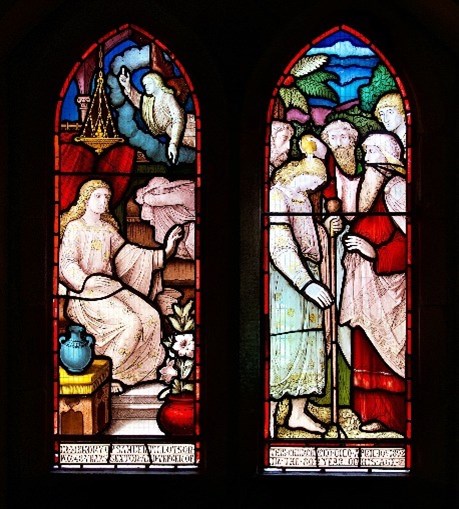 The other stained glass window that Frances Knowles was to see before he left was the one in the South porch. This consists of two lights depicting 2 events in the life of Samuel. The one on the left represents the call of Samuel as a boy in the temple, with Eli asleep. The other represents Samuel, as a prophet, anointing David, in the presence of his brothers, as King, by pouring oil upon his bowed head.
The other stained glass window that Frances Knowles was to see before he left was the one in the South porch. This consists of two lights depicting 2 events in the life of Samuel. The one on the left represents the call of Samuel as a boy in the temple, with Eli asleep. The other represents Samuel, as a prophet, anointing David, in the presence of his brothers, as King, by pouring oil upon his bowed head.
The inscription at the bottom of the window says “In memory of Samuel Tillotson, for 48 years sexton and verger of this church, who died April 10th 1892, in the 80th year of his age”. Samuel, a shoemaker by trade, also rang the church bell. His gravestone can be found against the Vicarage wall only a few yards from the vestry. It tells us that Samuel was married twice, both times to a lady called Grace. The first Grace died at the age of 37 and the second Grace died in 1896. Between them they gave birth to eight children, but sadly only three of them survived childhood. This window was fitted just before Francis Knowles left Silsden in September 1892.
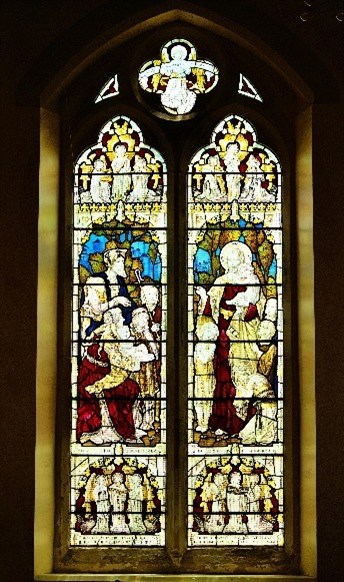 He was followed by John Barry who was to see the first stained glass window fitted in the South wall of the church. At the bottom of the window is the dedication sentence “In gratitude to Almighty God for giving them such a mother, and in ever loving memory of her, this window is dedicated by the eight sons of Ann Spencer, Easter, 1895”. The main part of the window depicts a father and mother presenting their family of eight children to Christ for blessing. Underneath are the words of Jesus “Suffer little children to come unto me, and forbid them not, for of such is the Kingdom of God”
He was followed by John Barry who was to see the first stained glass window fitted in the South wall of the church. At the bottom of the window is the dedication sentence “In gratitude to Almighty God for giving them such a mother, and in ever loving memory of her, this window is dedicated by the eight sons of Ann Spencer, Easter, 1895”. The main part of the window depicts a father and mother presenting their family of eight children to Christ for blessing. Underneath are the words of Jesus “Suffer little children to come unto me, and forbid them not, for of such is the Kingdom of God”
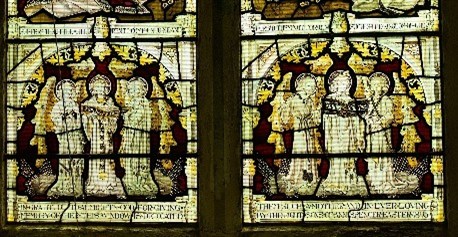
Ann Spencer was born Ann Roberts, and like her husband, John Spencer, was born in Silsden. John was a blacksmith and in his spare time, was an accomplished player of the violin and viola, a musical ability passed on to his sons. Father and sons together formed the Spencer's String Band who played at many local events. The eight sons were born between 1844 and 1868, all at Silsden, before the family moved to Keighley. After a busy life as mother and wife, Ann died at Keighley on the 1st May 1894 aged 71 and was buried in Silsden churchyard. Her eight sons lost no time in deciding to present a window to Silsden Church in her memory. Her seventh son, Augustus, who was then headmaster of the School of Art at Leicester, designed the window. The colourful window behind the choir stalls was later given in his memory by his younger brother, Beckwith.
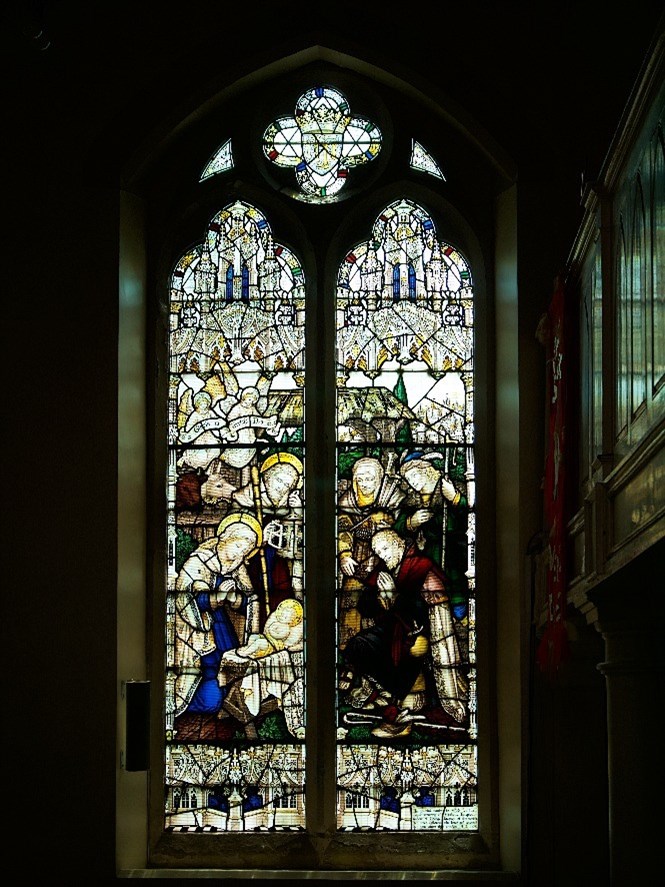 The next stained glass window to be fitted in the church is the one on the south side near the West door. This window depicts Joseph and Mary with the infant Christ in the stable, with an ox and ass looking on. Above them are two angels holding a scroll text with the words “Gloria in Excelsis Deo”. Three shepherds, one holding a type of bagpipe are shown revering the newborn Saviour with Bethlehem visible in the background. In the bottom right hand corner is the dedicatory inscription “In grateful thanks to God for the dear memory of Arabella Jacques, widow of George Jacques of this parish, her three children who loved and honoured her have given this window AD 1925”.
The next stained glass window to be fitted in the church is the one on the south side near the West door. This window depicts Joseph and Mary with the infant Christ in the stable, with an ox and ass looking on. Above them are two angels holding a scroll text with the words “Gloria in Excelsis Deo”. Three shepherds, one holding a type of bagpipe are shown revering the newborn Saviour with Bethlehem visible in the background. In the bottom right hand corner is the dedicatory inscription “In grateful thanks to God for the dear memory of Arabella Jacques, widow of George Jacques of this parish, her three children who loved and honoured her have given this window AD 1925”.
After losing their first three children when still young, George and Arabella Jacques went on to have three more children, a son and two daughters, who all lived a full life. George died in 1895 but his widow continued to live at Spring Bank until her death in 1924.Then 89 years of age, she was Silsden's oldest resident. Her children asked for the window to be erected where it is because it is near to where their mother had sat for many years.
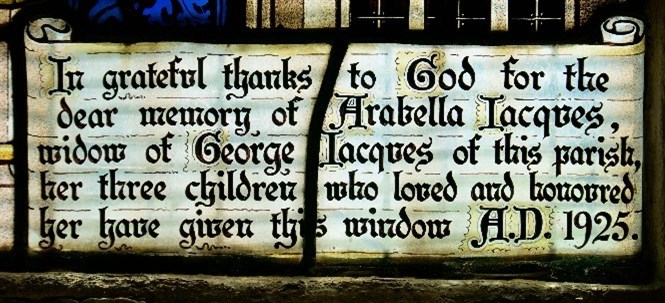
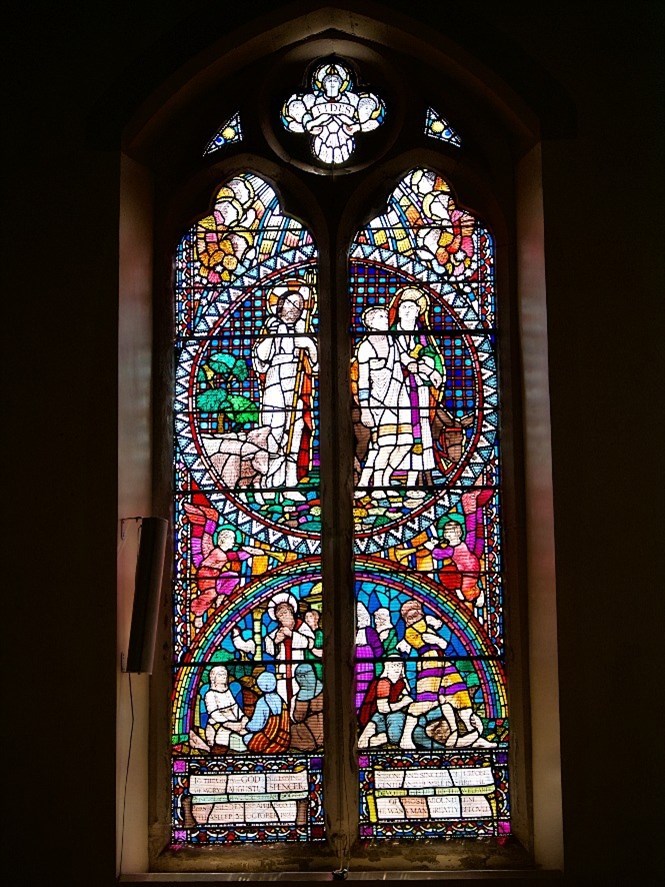 And so to the window behind the choir stalls, the most colourful window in our church. The dedication at the bottom of the window says “To the glory of God and in loving memory of Augustus Spencer, principal of the Royal College of Art 1900 - 1920. Born at Silsden 18th April 1860, he fell asleep 3rd October 1924. Strong and sincere of purpose, gentle and humble in spirit, he devoted his life to the welfare of those around him. He was a man greatly beloved”.
And so to the window behind the choir stalls, the most colourful window in our church. The dedication at the bottom of the window says “To the glory of God and in loving memory of Augustus Spencer, principal of the Royal College of Art 1900 - 1920. Born at Silsden 18th April 1860, he fell asleep 3rd October 1924. Strong and sincere of purpose, gentle and humble in spirit, he devoted his life to the welfare of those around him. He was a man greatly beloved”.
Although born in Silsden, Augustus moved with the family, just after his 8th birthday and also the birth of his younger brother, Beckwith, to Keighley where his father founded a blacksmith’s shop off Hanover Street. In Keighley, Augustus started as a half time pupil at Keighley Free Grammar school. The other half of the day he worked at the Keighley Mill belonging to Swire Smith. Augustus owed much to Swire Smith who recognised his artistic talents and encouraged him to gain a scholarship to Keighley School of Art. Here he won another scholarship this time to the Royal College of Art in South Kensington, which he entered in 1881.
He left South Kensington in 1885 to take up his first post as headmaster of the School of Art at Coalbrookdale in Shropshire. Three years later, he moved to become headmaster of the School of Art in Leicester. Whilst here, both his parents died and he designed the window erected in his mother's memory.
In 1900, he left Leicester to take up the post of principal of the Royal College of Art where he remained until he retired on a pension in 1920. Unfortunately during his retirement he did not enjoy good health. In 1924 he came to Silsden to stay with his friends Mr and Mrs John Booth at Howden House. Sadly he was taken seriously ill whilst he was there and died on the 3rd October.
Two years later, his younger brother Beckwith, wrote to the vicar of Silsden, Edwin Peters, saying that his friend, Mr Arthur Martin and himself “would like to erect a stained glass window in memory of my brother, the late Augustus Spencer, next to the one in memory of my mother. The subject we propose is the Good Samaritan as being the one most expressive of his character. Mr PW Cole of the Hastings School of Art, an old pupil of my brother, is preparing the design”.
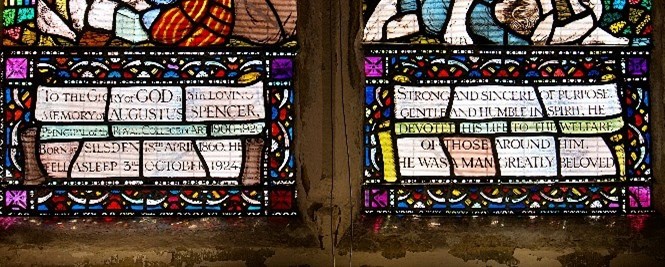 The PCC quickly approved the design and Philip Cole, assisted by his wife, began to make the window at his own house. When the work was finished, the job of erecting the window was undertaken by Henry Gill, of Kirkgate, a member of the choir and sidesman at Saint James. The window was dedicated on Whitsunday 5th June 1927.
The PCC quickly approved the design and Philip Cole, assisted by his wife, began to make the window at his own house. When the work was finished, the job of erecting the window was undertaken by Henry Gill, of Kirkgate, a member of the choir and sidesman at Saint James. The window was dedicated on Whitsunday 5th June 1927.
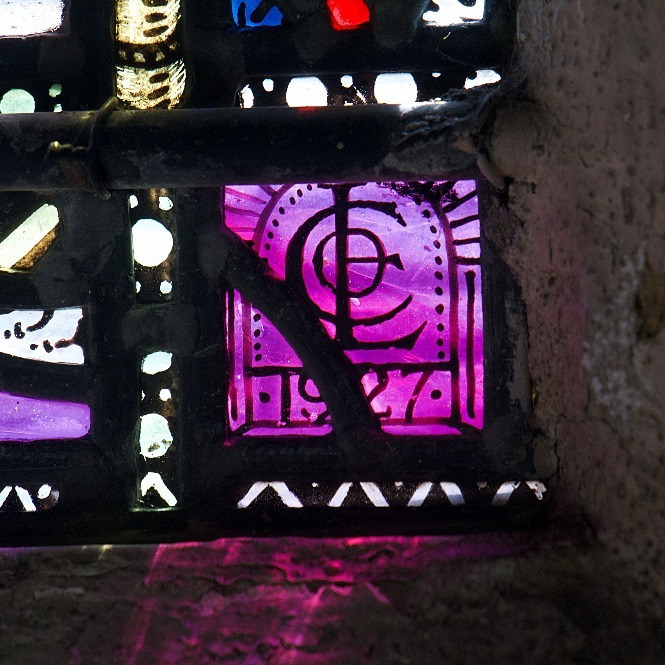 The church magazine of July 1927 described the window in these words “the top lights represent the Good Shepherd and the Good Samaritan, the bottom portion our Lord denied by Saint Peter and the claim upon the sympathy of the man fallen among thieves denied by the Priest and Levite, who are passing him by”. In a letter to the vicar Philip Cole says that “the colour scheme is intended to be an analysis of light in its separate colours”. Hence the reason for the rainbow in the window. Another thing to look for is Philip Cole’s initials in the bottom right hand corner.
The church magazine of July 1927 described the window in these words “the top lights represent the Good Shepherd and the Good Samaritan, the bottom portion our Lord denied by Saint Peter and the claim upon the sympathy of the man fallen among thieves denied by the Priest and Levite, who are passing him by”. In a letter to the vicar Philip Cole says that “the colour scheme is intended to be an analysis of light in its separate colours”. Hence the reason for the rainbow in the window. Another thing to look for is Philip Cole’s initials in the bottom right hand corner.
John Berry
John Berry began his ministry at Silsden in October 1892. As we have already mentioned, it was during his time here that the window in memory of Ann Spencer was installed. But this was only one of many changes and additions to the church which happened before he moved to another parish in 1915.
The first edition was a new Alms dish. Mr Berry's request for someone to give the money for this was soon answered. 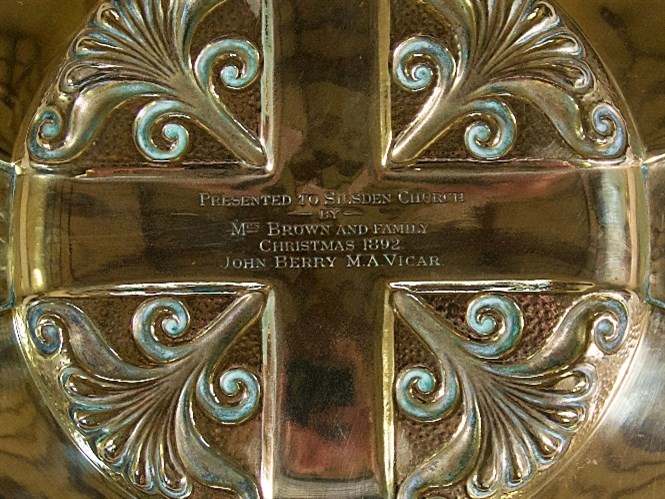 On the underside of the dish, which we still use today, can be found the inscription “Presented to Silsden Church by Mrs Brown and family, Christmas 1892 John Barry MA Vicar”.
On the underside of the dish, which we still use today, can be found the inscription “Presented to Silsden Church by Mrs Brown and family, Christmas 1892 John Barry MA Vicar”.
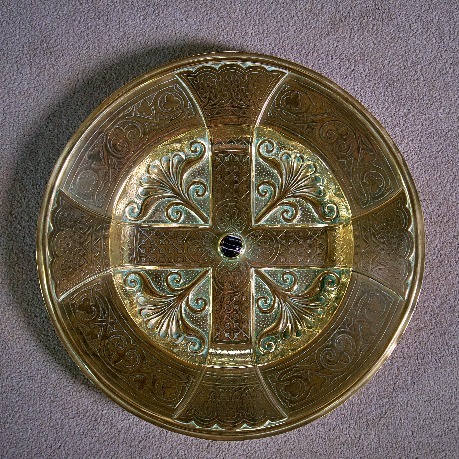
Externally the church took on a new appearance in 1895. A few months before he died in February 1895 George Jacques gave the church the money to make the tower higher so that it could accommodate a peal of bells and a clock which we still have today. The bells were cast by Warne and Sons of London and the clock was made by W Potts of Leeds. They were dedicated by the Bishop of Richmond on 3rd August 1895 when the clock was started by Mrs Jacques at 4 o'clock.
The new bells meant that the old bell which had come from Skipton Castle in 1712 was no longer needed and was returned to its original home.
 In 1897 the nation was celebrating Queen Victoria's Diamond Jubilee. The son and two daughters of the late George Jacques decided to give something to Silsden Church as a Diamond Jubilee offering and in memory of their father. This was the brass eagle lectern which made its first appearance on the occasion of the Harvest Festival 26th September 1897, when special dedicatory prayers were said.
In 1897 the nation was celebrating Queen Victoria's Diamond Jubilee. The son and two daughters of the late George Jacques decided to give something to Silsden Church as a Diamond Jubilee offering and in memory of their father. This was the brass eagle lectern which made its first appearance on the occasion of the Harvest Festival 26th September 1897, when special dedicatory prayers were said.
The parish magazine of October 1897 describe the lectern as follows “The makers were Benham and Froud of London, who also made the ball and cross that surmount the Dome of Saint Paul's cathedral. The lectern is a very handsome one of polished brass, in the perpendicular-gothic style, its base being fitted with three flying buttresses and the shaft ornamented with cut agates. It is surmounted by a half globe and a large natural eagle in the attitude of springing from the same. The wings of the eagle are outstretched and the head half turned and every feather is carefully chased by hand. Upon the outstretched wings is fixed the beautiful bookrest, with the letters IHS in the centre and flanked on either side with the design of ecclesiastical pillars and arches. On the base is the following inscription “To the Glory of God and in memory of George Jacques, who died January 14th 1895. Presented to Silsden Church by the family”.
The following year, 1898, was a notable date in the history of Silsden Church. As we have read Silsden Church was built in 1712 as a Chapel of Ease in the Parish of Kildwick, with a perpetual curate taking the services. Although a licence to register births and deaths was granted in 1801 and a licence to celebrate marriages followed in 1845, at which time Richard Heelis was known as the vicar, Silsden was still part of Kildwick Parish. 1898 saw Silsden become an independent parish. The following paragraph is taken from the Keighley news of Saturday February 9th 1898:
"Her Majesty in Council has assigned to Saint James's Church, Silsden, as an entirely and absolutely independent parish, 'all that part of the parish of Kildwick, in which is comprised within and is co-extensive with the ancient limits of the township of Silsden'. The church has been in the ecclesiastical parish of Kildwick since its erection in 1712 and the “declaration of independence” was formally made by the Vicar (Rev John Berry) on Sunday last."
The occasion was celebrated the following Friday with the steeple being decked with a flag for the visit of the Bishop of Ripon, Right Rev Dr Boyd Carpenter to take a Confirmation Service.
Towards the end of 1898, proposals were being made to build a new Vicarage to replace the building that was originally occupied by Richard Heelis 60 years before. The following year demolition work began and a new Vicarage was built on the same site. This is the building now called The Old Vicarage and was completed in 1902 when John Barry and his wife, Emmeline, moved in.
A few years later in 1905 a new wall was built at the bottom of the churchyard, in line with the front of the Town Hall. The old wall had been giving way and in some places bulging to such an extent that, unless something was done, a collapse was inevitable. To compliment a new wall, new gates donated by Mr PL Jacques, son of George Jacques, were installed.
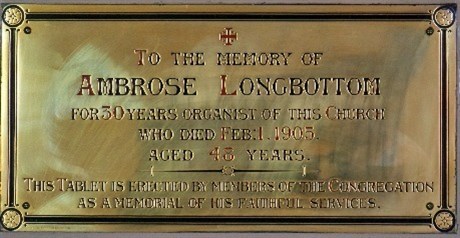 1905 also saw the inaugural meeting of Saint James's branch of the Mothers’ Union, of which Mrs Berry was the first secretary. Mrs Berry was also the branch secretary of the Girls Friendly Society which was a very well supported group at this time. 1905 also saw the death of Ambrose Longbottom, the church organist. He was obviously well thought of because after his death members of the congregation donated the money for a brass tablet, to be hung on the north wall, in his memory. This can still be seen near to the front pew by the font. It reads “To the memory of Ambrose Longbottom, for 30 years organist of this church, who died February 1st 1905, aged 48 years”. Note that Mr Longbottom started playing the organ at an early age.
1905 also saw the inaugural meeting of Saint James's branch of the Mothers’ Union, of which Mrs Berry was the first secretary. Mrs Berry was also the branch secretary of the Girls Friendly Society which was a very well supported group at this time. 1905 also saw the death of Ambrose Longbottom, the church organist. He was obviously well thought of because after his death members of the congregation donated the money for a brass tablet, to be hung on the north wall, in his memory. This can still be seen near to the front pew by the font. It reads “To the memory of Ambrose Longbottom, for 30 years organist of this church, who died February 1st 1905, aged 48 years”. Note that Mr Longbottom started playing the organ at an early age.
 Two years later, members of the congregation again donated money to the church, this time for the cross that now stands behind the altar. The brass cross, made at the Keswick School of Industrial Art, has a design of the “Agnus Dei ”, the “Lamb of God”, at its intersection and originally stood on the altar. It was 60 years later that the cross was mounted on its present stand.
Two years later, members of the congregation again donated money to the church, this time for the cross that now stands behind the altar. The brass cross, made at the Keswick School of Industrial Art, has a design of the “Agnus Dei ”, the “Lamb of God”, at its intersection and originally stood on the altar. It was 60 years later that the cross was mounted on its present stand.
For many years in the early 1900s, the choirmaster at Silsden was Mr HB Summerscales. The parish magazine tells us that in the autumn of 1911, after a service, Mr PL Jacques, son of George and Arabella, complimented Mr Summerscales on the delightful manner in which the services were rendered. Mr Summerscales accepted the compliment and then added “but we want a better organ”. “Yes we do” replied Mr Jacques and Mr Somerscales added “well you will perhaps do something handsome towards one when we make a start”. Mr Jacques replied that he would do so.
It wasn't long after this conversation that John Barry was talking with Mr Jacques, Mr Summerscales was contacting the firm of Harrison and Harrison of Durham and John Barry was announcing to the congregation that a new organ was being given to the church. The organ was to cost £500 but this original estimate was increased by the addition of two extra stops and also by having it blown by hydraulic power.
The new organ was situated where the pulpit and font are now and was dedicated on Sunday March 23rd 1912. The first piece to be played at a service in church was the doxology “Praise God from whom all blessings flow”. The arrival of a new organ was perfectly timed to add to the celebrations of Silsden Church’s bi-centenary.
Bi-Centenary 1712-1912
The celebrations of 1912 were the first of their kind at Silsden church. There are no records of any observances being made in 1762, 1812 or 1862. So, as John Berry wrote in the parish magazine, “our observance of this occasion has therefore set an example and established a precedent for future generations”. The celebrations did not consist of feastings, entertainment or parties, but of celebratory services on Saint James's day and on the two Sundays before and after that day.
Sunday July 21st began with Holy Communion at 8:00 am; this was followed by morning prayer at 10:30 am at which the preacher was the Rural Dean; a children's service was at 2:00 pm and evensong at 6:30 pm at which the preacher was the Bishop of Richmond. For this service the church was packed to the doors.
On Thursday July 25th, St James's Day, the first service of Holy Communion was at 5:00 am. At this service people were encouraged to come in their ordinary working clothes. The time set for the service enabled the 94 who came to have some breakfast before going to work. There followed another Holy Communion service at 7:15 am and Morning Prayer and Holy Communion at 10:30 am.
The weather in the morning had been fine and warm but there was a violent thunderstorm in the early afternoon. Thankfully this had stopped by 3:00 pm when the Bishop of Ripon and his wife arrived in their motor, to be greeted by the ringing of the church bells. After the churchwardens had taken them on a tour of the village they went to a packed church hall and chatted informally with the people there. Then came a few songs by ladies of the congregation, followed by afternoon tea. The social gathering finished with addresses from the vicar and the Bishop.
At 7:00 pm the church was packed for evensong at which the Bishop preached. The parish magazine reported that “later in the evening the Bishop and Mrs Drury had a hearty send off with cheers by a large crowd that awaited their departure. Altogether the day had been a most happy one and we were not only cheered by the presence of the Bishop and Mrs Drury, but they were cheered by their visit to Silsden”.
The celebrations continued on the following Sunday. Holy Communion at 8:00 am was followed at 10:00 am by Morning Prayer at which the vicar preached. At 2:00 pm there was a scholars' service which included a talk by the vicar. While this service was taking place there was another violent thunderstorm, so extra hymns were sung and a second talk was given by the vicar until the storm stopped. Evensong was at 6:30 pm with the Archdeacon of Craven giving the last sermon of the bi-centenary services. At the last service alone, the collection was just over £50, a tremendous offering in 1912.
The celebrations were brought to a close on the following Saturday when the bell ringers rang a peal of 5040 changes in honour of the event. Visiting ringers had done this before at Silsden but this was the first time that a Silsden band of ringers had accomplished such a feat.
In the August edition of the parish magazine, John Berry wrote that the celebrations had “set an example and established a precedent for future generations. As the mists of time deepen around the commemoration, our doings will still stand clearly as evidence that there was a living power and strong vitality in our religion when we celebrated this 200th anniversary”.
John Berry remained at Silsden until May 1915, having been vicar for 22½ years, making him the longest serving vicar up to that time. He moved to take up the living at Kirkby Thore, near Appleby in Westmorland.
John Barry's record was to be broken by his successor, Edwin Ernest Peters, who was to be vicar for the next 32 years.
Edwin Ernest Peters
Edwin Peters came to Silsden in August 1915, having spent the previous two years as curate-in-charge at Harden, which was then in Bingley Parish. His Institution service was taken by the Bishop of Ripon, with the induction by the Archdeacon of Craven. This was the first time that such a service had taken place in Silsden as, previous to this, new Vicars had been given charge of the parish by the Bishop in his own palace.
Mr Peters served the Parish for most of the two World Wars and for the first years of the new Diocese of Bradford, which came into being in 1919. He was twice Rural Dean of South Craven, from 1932 - 6 and from 1942 - 5. He was the first Silsden Vicar to become a Canon when, in 1944, he was made an Hon Canon in the stall of Saint Hilda. He was responsible for the creation of the Silsden Branch of the Church of England Men’s Soc. He was regarded as a very conscientious minister, being most assiduous in his visits to the sick and to the hospitals. An indication of the esteem and affection that Mr Peters had in the hearts of the people of Silsden is the cheque for £500 (a substantial sum in 1947) that was given to him when he left.
Mr Peters was married to Edith Letitia and they had two sons and a daughter. He was well known for riding a horse and keeping Airedale Terriers, for wearing a monocle and for campaigning successfully on his own to keep open the footpath over the Moors between Silsden and Ilkley.
It was due to ill health that Mr Peters resigned the living at Silsden and, sadly, his health also prevented him from preaching a farewell sermon. He and his wife went to live with one of their sons in Maidenhead, Berkshire. It wasn't long before Canon Peters had to go into a nearby nursing home ,where he died on 13th October 1947, the day before his 71st birthday.
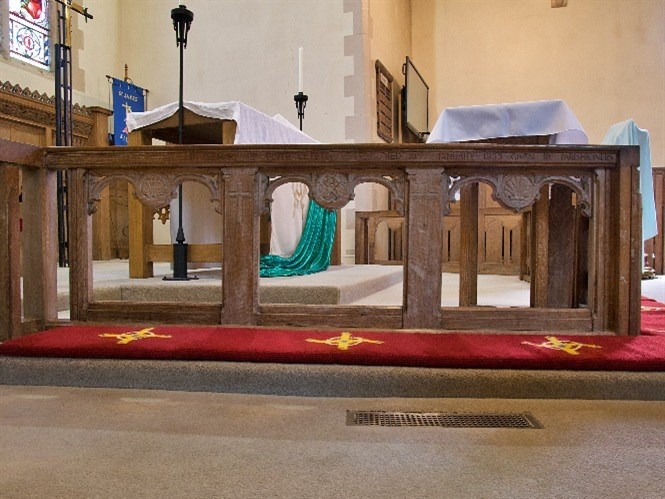 Mrs Peters died just over five years later. Both Mr and Mrs Peters have memorials within our church. The altar rail was given in memory of Mrs Peters. Along the top rail there is an inscription which reads: “Given by parishioners of Silsden and friends. In thankfulness and remembrance of Edith Letitia Peters, died 10th January 1953”.
Mrs Peters died just over five years later. Both Mr and Mrs Peters have memorials within our church. The altar rail was given in memory of Mrs Peters. Along the top rail there is an inscription which reads: “Given by parishioners of Silsden and friends. In thankfulness and remembrance of Edith Letitia Peters, died 10th January 1953”.
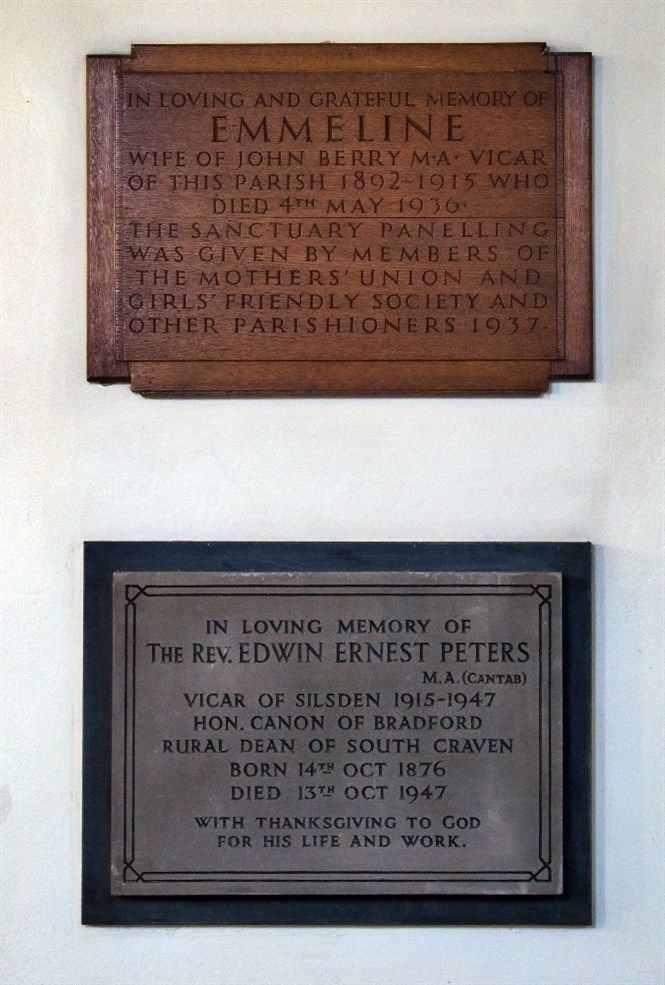 Near the back wall of the church there is a memorial tablet on the South wall. It reads: “In loving memory of the Rev Edwin Ernest Peters MA (Cantab), Vicar of Silsden 1915 to 1947, honorary Canon of Bradford, Rural Dean of South Craven. Born 14th October 1876. Died 13th October 1947. With thanks to God for his life and work”.
Near the back wall of the church there is a memorial tablet on the South wall. It reads: “In loving memory of the Rev Edwin Ernest Peters MA (Cantab), Vicar of Silsden 1915 to 1947, honorary Canon of Bradford, Rural Dean of South Craven. Born 14th October 1876. Died 13th October 1947. With thanks to God for his life and work”.
This memorial tablet was originally in the sanctuary, as was the memorial tablet that can be seen above it. This is in memory of Emmeline Berry who died during the incumbency of Canon Peters. It reads: “In loving and grateful memory of Emmeline, wife of John Barry MA, vicar of this Parish 1892 to 1915, who died 4th May 1936. The sanctuary panelling was given by members of the Mothers Union and Girls Friendly Society and other parishioners in 1937.
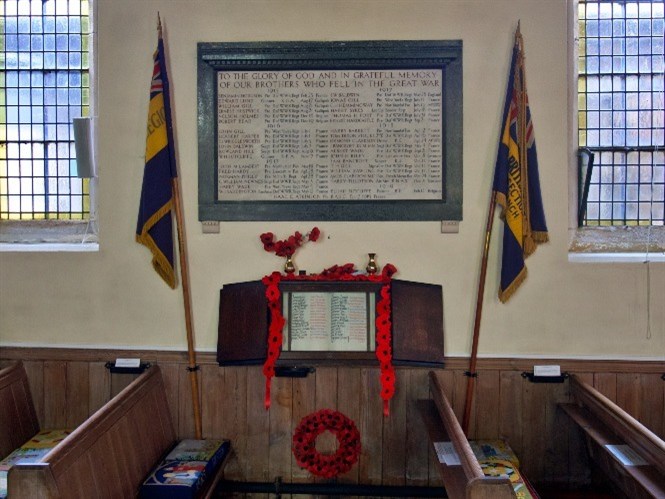 Opposite these two memorials, on the north wall, is another memorial that was given to the church whilst Canon Peters was vicar. This is the War Memorial that was made after the end of the First World War. The following is taken from a report in the Keighley News of Saturday 11th September 1920. “A mural tablet to the memory of the men from the Silsden Parish who made the supreme sacrifice in the Great War was unveiled by Major Arthur Driver and dedicated by the Bishop of Bradford (Dr A W Perowne), at an impressive service in the Silsden Parish Church on Saturday afternoon. About two yards long by 1½ yards wide, the tablet has been placed on the left side of the wall looking towards the altar, about the centre of the church. It is of white marble, bordered with marble of a deep greenish hue with greyish white veins and contains the names of 37 men who fell. Across the top runs the inscription, “To the glory of God, and in memory of our brothers who fell in the war”, the names of the men being engraved in red and the names of the regiments and dates of death in black. Resting on the top of the tablet was a wreath of evergreens and after the service a number of floral tributes were placed underneath as tokens of remembrance.
Opposite these two memorials, on the north wall, is another memorial that was given to the church whilst Canon Peters was vicar. This is the War Memorial that was made after the end of the First World War. The following is taken from a report in the Keighley News of Saturday 11th September 1920. “A mural tablet to the memory of the men from the Silsden Parish who made the supreme sacrifice in the Great War was unveiled by Major Arthur Driver and dedicated by the Bishop of Bradford (Dr A W Perowne), at an impressive service in the Silsden Parish Church on Saturday afternoon. About two yards long by 1½ yards wide, the tablet has been placed on the left side of the wall looking towards the altar, about the centre of the church. It is of white marble, bordered with marble of a deep greenish hue with greyish white veins and contains the names of 37 men who fell. Across the top runs the inscription, “To the glory of God, and in memory of our brothers who fell in the war”, the names of the men being engraved in red and the names of the regiments and dates of death in black. Resting on the top of the tablet was a wreath of evergreens and after the service a number of floral tributes were placed underneath as tokens of remembrance.
‘O rest in the Lord’ was played on the organ by Mr H Cooper ( organist) and the hymns “God of the living”, “For all the Saints” and “O God our help in ages past” were sung, while the choir rendered the anthem “Blessed are the departed” from Spohr’s Last Judgement, the quartet being taken by Miss Winnie Hill, Mrs H Barrett, Mr A Dixon and Mr Oswald Gill. The service was conducted by the vicar (the Rev E E Peters) and the lesson was read by Mr W Basnett. At the conclusion of the service the Last Post was sounded by Bugler N Crabtree."
The Post-War Years
After having only two vicars in the past 55 years Silsden was to have seven in the next 53 years. The first of these was Francis Green who was to be the parish’s shortest serving vicar. He was a popular incumbent but was only here for four years, having to resign because of ill-health in 1951.
February 1952 saw the arrival of William McKee who was to stay here for six years. These six years saw a revival in the Sunday School and also saw the return of the old bell which had been given to Silsden Church in 1712. As mentioned previously, when the church tower was made higher and a peal of bells installed, in 1895, the old bell had returned to Skipton castle. Lord Hothfield, a descendant of the Earl of Thanet, had paid £5 for it. Back at Skipton castle, it stood in the hall and was used as a dinner gong.
In September 1956 there was an auction of the effects of Skipton Castle. The bell was Lot 69. William McKee went along to the sale and managed to buy the bell for £40. So, after 60 years absence, the old bell was back home in Silsden Church.
When William McKee left in 1958, he was replaced by John Lambert-Smith. During his five years here, he introduced the concept of Christian Stewardship to the congregation. Pamphlets were produced explaining the principles of stewardship and parish visitors called at the doors of church members to help people decide what they could do. People were asked to consider how best they could use their time, talents and money in the service of God. The aim was for people to be more involved in church life and to commit oneself to give one's monetary contribution weekly and not just when one attends a church service. This is something that the church practises today with weekly envelopes. It was during John Lambert-Smith’s incumbency, in 1962, that Silsden Church had its 250th anniversary. The calendar that year was the same as 2012 with Saint James’s day falling on a Wednesday. The following are two reports from the Keighley news on Friday 27th July 1962.
“Gift dedicated
In connection with Christian Family Year, the Rev J H Lambert-Smith, vicar, conducted family morning prayers at Silsden Parish Church on Sunday. The theme of the sermon related to the responsibilities of fatherhood. There was also a service of dedication when the vicar dedicated several gifts to the church by organisations and individuals to mark the 250th anniversary of its existence. One of the four patrons of the church, Mrs Elizabeth Driver, formerly of Moorfield and now of Glasgow, gave 115 new hymn books and these were distributed to the congregation. A white pulpit veil and bookmarkers were the gift of Mrs D Wade and family and green and red bookmarkers were given by the Young Wives. The Girls’ Friendly Society, Townsend fellowship, gave white veils and purificators. There was a large congregation and the organist was Mrs Alice Bradley, choir mistress.”
“Church history
When, as part of their 250th anniversary celebrations, the leaders of Silsden Parish Church wished to publish a history of their church, they had no problem in finding an author with the requisite knowledge. In one of their own members, Mr William Cowling, they had a man who had spent a lifetime on research into the history of Silsden and the church. In an attractive illustrated booklet Mr Cowling tells the story of negotiations leading to the church's foundation and of subsequent happenings over 250 years. No better illustration of this could be found than the fact recorded by Mr Cowling that one of his ancestors, Peter Cowling, was one of three Yeoman who bought the site for Silsden Parish Church from the Earl of Thanet in 1711. Since then Silsden’s population has grown from less than 600 to some 5600, yet still the Wades, Clarks, Tillotsons, Gills and Longbottoms predominate.
The excellent illustrations in the booklet are from blocks made by the late Mr William Henry Lambert and the front bears a pleasing picture of Silsden Parish Church with White Crag behind, which was drawn by Mr Eddie Parker.”
Copies of William Cowling's booklet can still be found and it has been a very useful source of reference in writing this booklet.
The Re-ordering of the interior of the church in 1967
John Lambert Smith left Silsden in 1963 and was succeeded by Michael Barton. He was to instigate and see the completion of the biggest change in the appearance of the interior of the church since the 19th century. A report in the Craven Herald and Pioneer in March 1965 reads as follows
"Silsden plan for church alterations
Some reconstruction of Silsden parish church interior, long regarded as desirable but not feasible owing to lack of funds, now appears likely to be achieved.
The Rev Michael Barton, the vicar, said at the annual parochial meeting last night that the charity commissioners were now drawing up a scheme to free money long tied up in the new church fund.
Mr Barton said in addition, Mr George Pace of York, a leading church architect, has been invited to draw up detailed plans for the re ordering of the church on the basis of his preliminary report.
The general character of the church will be unchanged, but the improvements will give extra space and dignity, especially for the administration of the sacraments of baptism and Holy Communion.
Mr Barton said the organ would be moved to the gallery, the sanctuary would be enlarged and there would be new lighting.
Mrs Elizabeth Driver, one of the three patrons of the living, had offered to provide a pair of candlesticks which Mr Pace was to design.
The work of the architect mentioned, George Pace, can also be seen at Holy Redeemer, York and at the William Temple Memorial church at Wythenshawe, Manchester, among other churches.
Undoubtedly, the biggest task that George Pace's plans involved was the moving of the organ to the gallery (or the balcony as we now call it). One of the people involved in this was David Smith who has since played the organ many times. Where the organ had stood before can now be found the font, moved from the back of the church. As in most churches, the altar had been up against the east wall, but now it was brought forward so that the priest faces the congregation. As mentioned earlier the "Lamb of God" cross that had stood on the altar, was now mounted on a stand. The large candlesticks, given by Mrs Driver are still with us, as is the new lighting that was installed.
The work was completed by the end of 1967 and the following is taken from the report of the Craven Herald and Pioneer of Friday December 5th 1967.
"Silsden Church Hallowed
The Bishop of Bradford, the Right Reverend Michael Parker, on Thursday week conducted a service of Halloween at Silsden Parish Church on the completion of a scheme for the re-ordering of the church interior. The occasion, he said, was a milestone in the life of a happy Parish and he congratulated the vicar, the Rev AM Barton, the architect, the church council and church workers generally. He also thanked the contractors who had done the work, some of whom were presented to him during the service.
The Bishop said that he was sure that, like him, everyone was happy at what had been accomplished in the church. “You are a very courageous man, he told the vicar. Most clergy get into trouble if they so much as dare to change a hymn tune, but you have changed the whole interior of your church. That is something which required a great deal of courage and I congratulate you on your leadership”.
To the congregation, the Bishop said, “Without full support, the vicar could not have carried out this scheme, so my second congratulations are to all of you at Silsden Parish Church. My next congratulations and my thanks, go to Mr George Pace, the architect who prepared this scheme of re-ordering. He regards this work as his Christian vocation to bring art into the service of God.
Let us rejoice tonight and may this be another milestone in the life of a happy Parish”.
The Vicar’s father, the Ven HD Barton, Archdeacon of Sudbury, Suffolk, preached the sermon. He said that any father present would understand his own feelings that night. Under the leadership of his son, a dream of many years had come true. He thought that everyone would be impressed by the homeliness of Silsden Parish Church. It was an open church where everything could be seen by the worshippers. The changes made and the brightness of the decoration made one realise there was joy in worship.
The service was followed by a reception in the Town Hall. The vicar welcomed guests, including Canon EC Hamer, Rural Dean, the Rev WM McKee and the Rev JH Lambert-Smith, two former vicars at Silsden, the Rev SA Selby (Kildwick), the Rev AL Bowman (Steeton), Fr Peter Bolger, Roman Catholic Parish Priest and members of Silsden Urban Council. He said that the Rev JD cope, Methodist Minister at Silsden, would have been present but for a circuit meeting and the Ven A Sephton, Archdeacon of Craven, also had a prior engagement.
Having given the Parish a new-look interior of the church, Michael Barton left Silsden to go to Moortown, Leeds in 1970, and was replaced by Timothy Gunter. In the ten years that Timothy Gunter was here, it was the grounds and the buildings around the church that were to take on a new look.
Today we are used to seeing the bottom half of the churchyard as a grass area, with the gravestones being confined to the upper half of the churchyard. In 1970, gravestones covered the whole area. Those at the bottom half were the oldest. Laws governing burial grounds allowed these stones and those marking the outside of the grave, to be removed and for the area to be flattened and grassed over. Some stones were used to make footpaths and some were stood against the wall on the South side. As each gravestone was removed, the details written on them were all recorded. At this time, cremations were beginning to outnumber burials and so a plot at the top end of the flattened area was, as it says on the stone at the end of the plot “set aside for the Interment of cremated remains AD 1974”.
On the opposite side of the church building, other changes would soon be happening. The first of these would be the church hall. The Parish magazine of March 1979, tells us that “the church's patterns of work change from generation to generation. Before television much of this town's entertainment took place, as the delicious memories of the elderly testify, in our church hall. Now, alas, it is falling to pieces and last year cost £1500 just in maintenance not including heating and cleaning.
The church council has decided to launch an appeal for £20,000 to rebuild the half of the hall which is nearest to the church providing a much lower modern building, suitable for the multifarious small meetings which happen daily in a Parish where there is energy and inspiration.
The local architects, Thornton and Newiss, whose office is at Beck House Farm, have drawn up a scheme which we shall soon have on view. Planning permission is being sought”.
It was not long before work got underway as did various money-raising activities, all of which of course took place at different venues which included people's homes, Staincliffe Court, the Methodist Church and the Town Hall. The latter was also used every Sunday for the children’s Sunday school.
The new, smaller, church hall was ready for use in April 1980. Although the building was only about half the size of the previous one, the church now had its own car park for the first time.
Sadly the vicar, Timothy Gunter, was not present at the opening of the new church hall because he had left Silsden in January to take up another incumbency at Sunninghill in the Oxford diocese. At his farewell gathering, the churchwarden said that many would remember him as a compassionate man whose faith and prayers have strengthened them. “Silsden was a better place for having him as vicar”.
Timothy Gunter was the last figure to live in what we now call the Old Vicarage. The diocese had decided before he left that the building was becoming too expensive to maintain and too big for the needs of a present day vicar. The building was put up for sale, but not all the garden. The present Vicarage was built in the garden of the Old Vicarage. Whilst digging and clearing the ground prior to laying the foundations, the sundial, which had been over the doorway of the church building of 1816, was unearthed and as stated earlier, it can now be seen on the South wall of the Vicarage.
When the next vicar, John Nowell, came in June 1980, the new Vicarage was not finished and so he started his incumbency living in Lower Park Green.
Although the new church hall was in use when he arrived, there was still money to be raised for the church hall fund. So the money-raising social events continued, and in time the church hall fund was replaced by the Renovation Appeal, to pay for the costs of alterations, repairs, maintenance etc of both the church and the church hall. A colourful addition to the church at this time, was the provision of colourful kneelers for every pew. All these were made and paid for by individual people.
The arrival of John Nowell in 1980, coincided with the introduction by the Church of England, of the Alternative Service Book (ASB). This was now the book to be used for public worship and, like the kneelers, these were paid for by individual donations. To complement the ASBs, new hymn books, “Hymns for Today's Church” were also donated by individual people.
The ASBs were used for the 10:30 Morning Service, but the Book of Common Prayer was still used for the 8:30 Morning Communion Service and for the Evensong Service. However the attendance at Evensong began to dwindle, and so instead of Evensong every week, monthly Healing Services and Praise Services were introduced.
To advertise these services and other church activities, the Parish magazine was given a new name “The Fisherman” and was produced in a larger A4 format.
Not long after celebrating 10 year’s ministry at Silsden, John Nowell left the parish in 1991 to become Baildon's new Vicar.
September 1992 saw the arrival of Silsden’s next vicar, John Cooper. His arrival was announced in the Church Magazine which had reverted to its former A5 size, but retained its new title “The Fisherman”.
John Cooper ministered in Silsden until he retired at the end of October 1999. During this time, a lifelong stalwart of our church, Miss Edith Clarke, died. For many years she had been headmistress at Aire View School and a leader of the Sunday School at Saint James. In 1996 our present altar was given in her memory. Later the sanctuary was further enhanced by the addition of an aumbry.
Another stalwart of Silsden Church, John Wilson, churchwarden and treasurer for many years, was honoured in 1997. On Maundy Thursday of that year, the Queen came to Bradford for the annual service at which she distributed Maundy Money. John Wilson was one of the recipients.
The mid-90s saw the installing of the church's first microphones, loudspeakers and loop system for those with hearing difficulties. It was also the time, unseen by many, when our present-day links with the two local schools were established.
The late 1990s saw the decline in numbers of people, both in Silsden and in other parishes, attending Sunday evening services. So it was that from 1998, only occasional Sunday evening services have been held.
Unfortunately, 1998-9 was dominated by the problem of the church tower and bells. The bells had not been rung for over 20 years because of the state of the tower, mostly caused by water damage. Just one bell had been rung on its own for some years but even that was no longer safe to do. Some basic repair work and some rebuilding was essential to make the tower safe. The cost of this was about £8500. To restore the bells as well as making the tower strong enough to ring them, would increase the cost to £50,000. It seemed an impossible task to raise this amount in the foreseeable future. However, shortly before John Cooper retired, an anonymous donor came forward offering to give sufficient money to cover the costs of both restoring the bells and making the tower safe enough for them to be rung.
So, the situation was resolved and work began, culminating on the 4th November 2001 with a special service being held at which Bishop David Smith dedicated the bells, prior to them being rung. Silsden's first 21st century Vicar, Peter Greenwood, had been here just over eight months.
At the same time as Peter Greenwood arrived the Common Worship Book had officially replaced the ASB in the Church of England. Sufficient copies for every pew were given to the church in memory of Fred and Hildred Halliwell, past members of Silsden church.
Peter Greenwood was here for just over 8½ years and during that time both the interior of the church and the churchyard saw additions. Before the problem of the tower had arisen, plans were made for a link to be built between the church and the church hall. The two buildings had always been separate with a ginnel between them. When the church hall was part demolished and rebuilt in the late 1970s, they still remained separate with just two opposite doors allowing access from one to the other. But now, at last, the plans that began in 1997 were looked at again and the present-day link was built in 2004.
Throughout the 20th century, the Driver family who had lived originally at Moorfield, a now-demolished house at Swartha, had been much involved in the life of Silsden church. Now a brass plate above the new doors into the church tells us that the doors were given in memory of Norman Driver and his sisters, Joan and Elizabeth.
Outside in the churchyard similar words can be seen on the back of the memorial stone at the top end of the plot set aside for the interment of cremated remains. Right from when this plot was first used, no individual memorial stones have been allowed, but from 2005 this stone has permitted people to have the names of their loved ones remembered in a visible way.
In 2003, the Silsden branch of the Royal British Legion was disbanded because of dwindling membership. So it is that the two standards are laid up in the church, one on each side of the War Memorial on the North wall. Although a new branch has now been formed, the standards are not allowed to be removed.
A very visible addition to the inside of the church is the carpet that was laid throughout the building, except for inside the pews. This happened in 2008. A less obvious addition is the present sound system which reflects the advances in technology since the original one was installed.
Sadly, amid these additions and improvements the last edition of the Parish Magazine, first produced in 1881, was produced in December 2006.
It had been the Parish Magazine that had told the parishioners that in July 2002 Rev June Medhurst would be coming to Silsden as assistant curate. She was to be the first assistant curate that Silsden had had. Having just been ordained as a Deacon, she was also the first ordained woman to serve in Silsden. June stayed here for four years before moving to Oxenhope.
June Medhurst and her husband were, of course, the first occupants to live in the house in Westerley Crescent after the Diocese had purchased it. They were followed in June 2006 by Michael Cansdale and family. Michael Cansdale became Silsden’s first male assistant curate. He left in June 2009 to take charge of Riddleston/East Morton Parish.
Three months after the Cansdale family left, Peter Greenwood and family moved to the parish of Gillingham in the Salisbury Diocese.
During the interregnum that followed, Mrs Pat Smith was ordained Deacon. Pat became the first woman member of Silsden congregation to be ordained and the first non-stipendiary assistant curate in the parish of Silsden.
The interregnum came to an end in September 2010 when history was created again. For the first time, the Vicarage was occupied by a husband and wife who were both ordained. David and Susan Griffiths were the first joint Vicars that Silsden has had.
During their first year here, the house in Westerley Crescent was occupied again, this time by the church’s 4th assistant curate, David Austin, who was ordained Deacon in July 2011.
The first few years of the 21st century has seen quite a few clergy come and go, as well as many unnamed lay people. The church building and its surroundings have also seen quite a number of changes. Nothing remains the same.
This is even more apparent if we look back 300 years. But one thing has not changed since 1712. The Parish Church of St James has been a witness to the ever present Christian faith in Silsden.
Let us pray that the church will continue to be a witness in the centuries to come.
Brian Turner, 20/03/2022